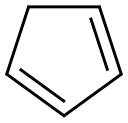시클로펜타디엔 C화학적 특성, 용도, 생산
화학적 성질
1,3-Cyclopentadiene is a colorless liquid that dimerizes
easily in the presence of peroxides and trichloroacetic acid
to a colorless solid.
물리적 성질
Colorless liquid with a turpentine-like odor. Odor threshold concentration is 1.9 ppm (quoted,
Amoore and Hautala, 1983).
용도
manufacture of resins; in organic synthesis as the diene in the Diels-Alder reaction producing sesquiterpenes, synthetic alkaloids, camphors.
생산 방법
This compound occurs in the C6–C8 petroleum distillation
fraction, and in coke oven light oil fractions. It is
produced by dehydrogenation of cyclopentadiene or monomerization
of its dimer.
정의
A cyclic hydrocarbon made by
cracking petroleum. The molecules have a
five-membered ring containing two carbon-
carbon double bonds and one CH
2
group. It forms the negative cyclopentadienyl
ionC
5H
5-, present in sandwich compounds,
such as ferrocene.
일반 설명
1,3-Cyclopentadiene is a colorless liquid with an irritating, terpene-like odor. Bp: 42.5°C; Flash point: 77°F. Density: 0.805 g cm-3.
반응 프로필
1,3-Cyclopentadiene is incompatible with strong oxidizing agents. Ignites on contact with oxygen (O2) and ozone (O3). Explodes on contact with fuming nitric acid or a mixture of sulfuric acid and nitrogen tetroxide. Reacts vigorously on contact with potassium hydroxide and other strong bases. Mixtures with air are explosive. Presents a moderate explosion hazard when exposed to heat or flame. Decomposes violently at high temperature and pressure. May form explosive peroxides in storage. Undergoes a spontaneous dimerization at room temperature to give DI1,3-Cyclopentadiene (C10H12, CAS No: 77-73-6), which is a low-melting solid (melting point: 32.5°C). The reaction is strongly exothermic (Hazardous Chemicals Desk Reference, p. 360 (1987)), but occurs sufficiently slowly that 1,3-Cyclopentadiene can be said to be stable at room temperature. The dimerization accounts for the partial or complete solidification of liquid 1,3-Cyclopentadiene in storage. Polymerization occurs more rapidly and extensively at higher temperatures. When heated to 180-200°C, 1,3-Cyclopentadiene gives poly1,3-Cyclopentadiene, a white waxy solid. Stronger heating breaks down poly1,3-Cyclopentadiene and re-generates the monomeric 1,3-Cyclopentadiene as a vapor. The vapor decomposes violently at higher temperatures and pressures.
건강위험
Cyclopentadiene exhibited low toxicity inanimals. Inhalation produced irritation of theeyes and nose. A 3-mL amount injected subcutaneouslyinto rabbits resulted in narcosis,convulsions, and death (von Oettingen 1940).A dose of≤ 1 mL was nontoxic. Repeatedexposure to 500 ppm caused liver and kidneyinjuries in rats; but longer repeated exposuresto 250 ppm produced no such effects in testanimals (ACGIH 1986). An oral LD50 valuein rats for the dimeric form has been recordedas 820 mg/kg (Smyth 1954).
화재위험
Flammable liquid; flash point (open cup)
32°C (90°F); fire- extinguishing agent: dry
chemical, foam, or CO2; a water spray
may be used to cool the surroundings. Prolonged
exposure to air may cause peroxide
formation.
Safety Profile
Low toxicity by
ingestion. A dangerous fire hazard when
exposed to heat or flame; can react with
oxidizing materials. Moderate explosion
hazard in the form of gas when exposed to
heat or by chemical reaction. It decomposes
violently at hgh temperatures and pressures.
dimerization is highly exothermic.
Explosive reaction with fuming nitric acid,dinitrogen tetroxide, sulfuric acid. Reaction
with nitrogen oxide + oxygen forms an
explosive product. Reaction with oxygen
forms a flame-sensitive explosive product.
Ignites on contact with oxygen + ozone.
Reacts vigorously on contact with potassium
hydroxide. Incompatible with oxides of
nitrogen, sulfuric acid. When heated to
decomposition it emits acrid smoke and
fumes.
잠재적 노출
Cyclopentadiene is used as an inter-
mediate in the manufacture of resins, insecticides, fungi-
cides, and other chemicals.
환경귀착
Biological. Cyclopentadiene may be oxidized by microbes to cyclopentanone (Dugan, 1972).
Chemical/Physical. Dimerizes to dicyclopentadiene on standing (Windholz et al., 1983).
운송 방법
UN1993 Flammable liquids, n.o.s., Hazard
Class: 3; Labels: 3-Flammable liquid, Technical Name
Required.
Purification Methods
Dry the diene with Mg(ClO4)2 and distil it rapidly as it dimerises readily at room temperature. It should be used immediately or stored in a Dry Ice or an ice-salt bath. HIGHLY FLAMMABLE. [Moffett Org Synth Coll Vol IV 238 1963.] Cyclopentadiene Dimer (4,7-methano-3a,4,7,7a-tetrahydroindene) has [77-73-6], M 132.3, m 33o, b 170o/atm, and d2 5 0.986; add ~0.05% of 2,6-di-tert-butyl-4-methylphenol as stabilizer. Cyclopentadiene is prepared when required by de-polymerising the technical grade dimer by heating it carefully under a fractionating column [Wilkinson Org Synth Coll Vol IV 467 1963], as described by Moffett (above reference), or by adding the dimer at a steady rate onto mineral oil heated at 240-270o (Korach et al. Org Synth 42 50 1962). [Beilstein 5 II 391.]
비 호환성
Vapors may form explosive mixture with
air. Converted (dimerized) to higher-boiling dicyclopenta-
diene upon standing in air and @ 32
F/0
C; this conversion
may be violent and exothermic; this reaction is accelerated
by peroxides or trichloroacetic acid. Reacts violently with
potassium hydroxide. Violent reaction with strong oxidi-
zers; strong acids; dinitrogen tetroxide; magnesium.
Incompatible with oxidizers (chlorates, nitrates, peroxides,
permanganates, perchlorates, chlorine, bromine, fluorine,
etc.); contact may cause fires or explosions. Keep away
from alkaline materials, strong bases, strong acids, oxoa-
cids, epoxides, alkaline earth metals, nitrogen oxides. May
accumulate static electrical charges, and may cause ignition
of its vapors.
폐기물 처리
Dissolve or mix the material
with a combustible solvent and burn in a chemical incinera-
tor equipped with an afterburner and scrubber. All federal,
state, and local environmental regulations must be
observed.
시클로펜타디엔 준비 용품 및 원자재
원자재
준비 용품








